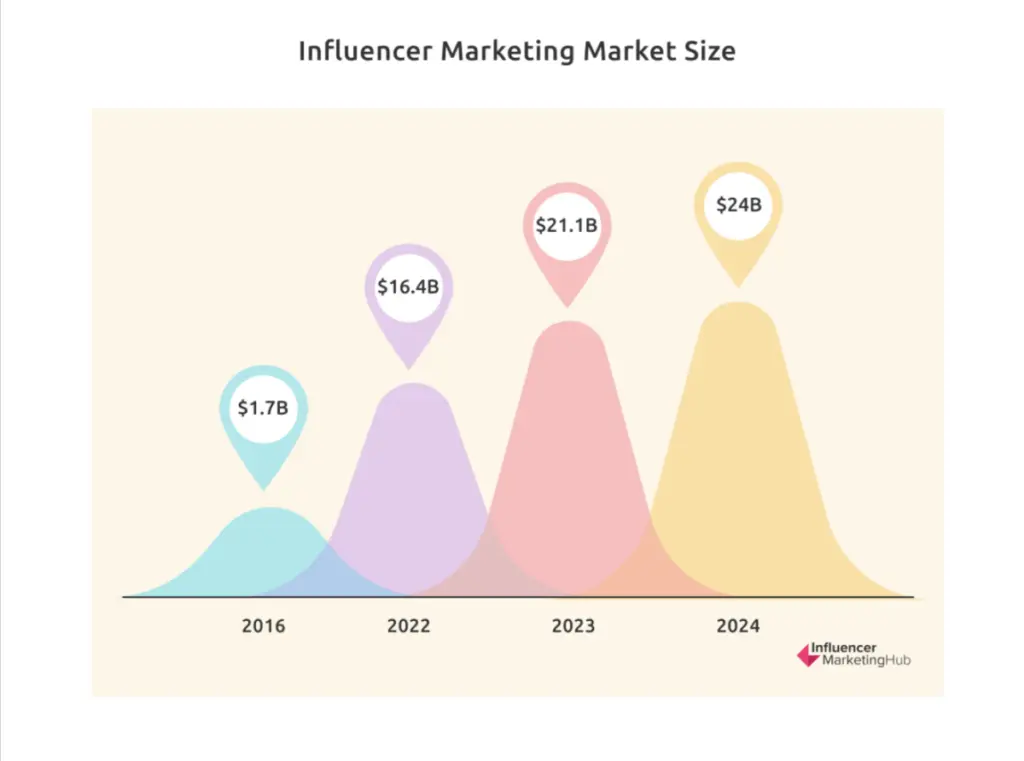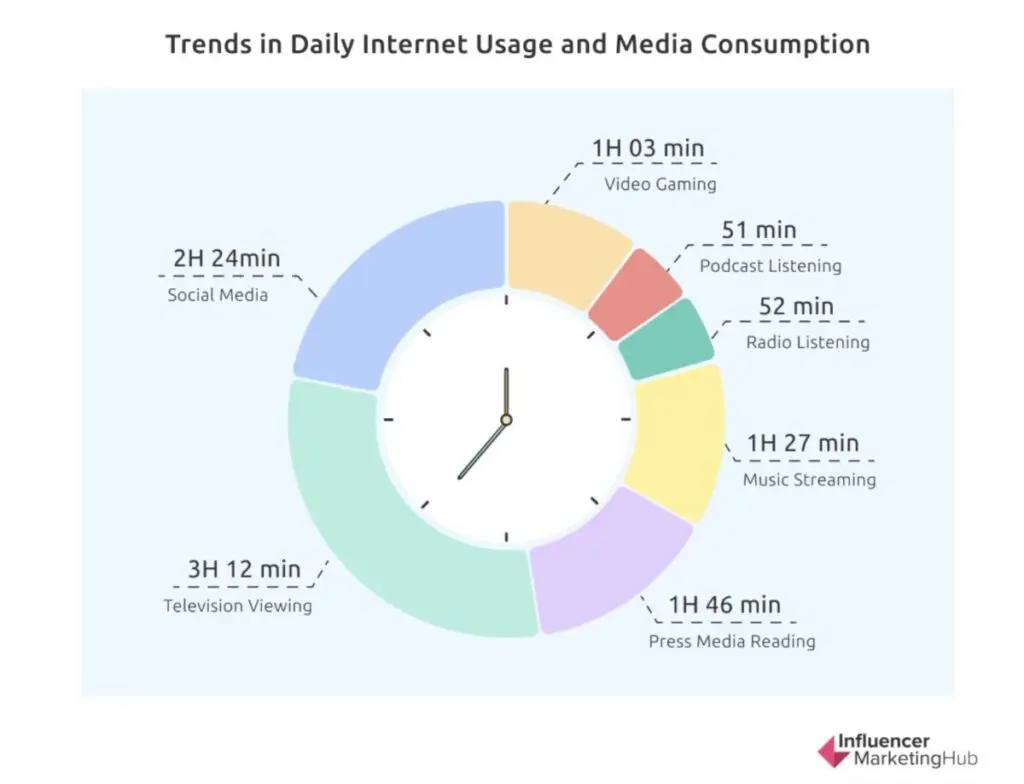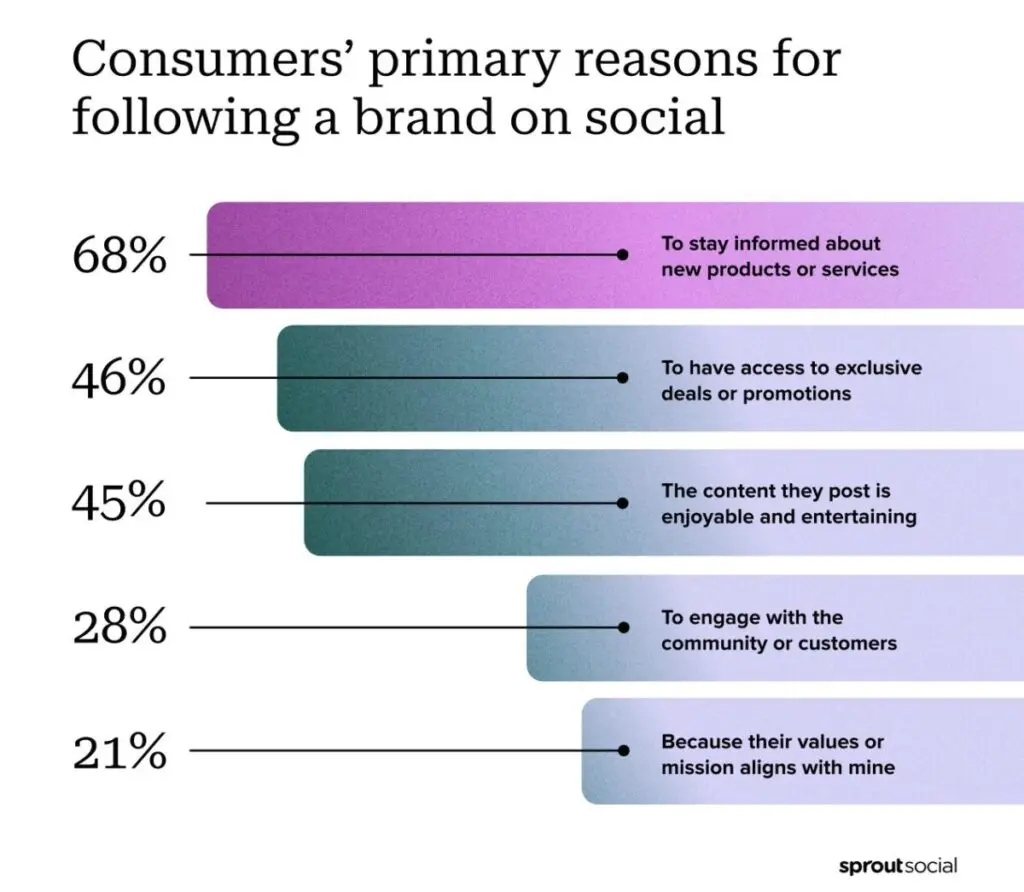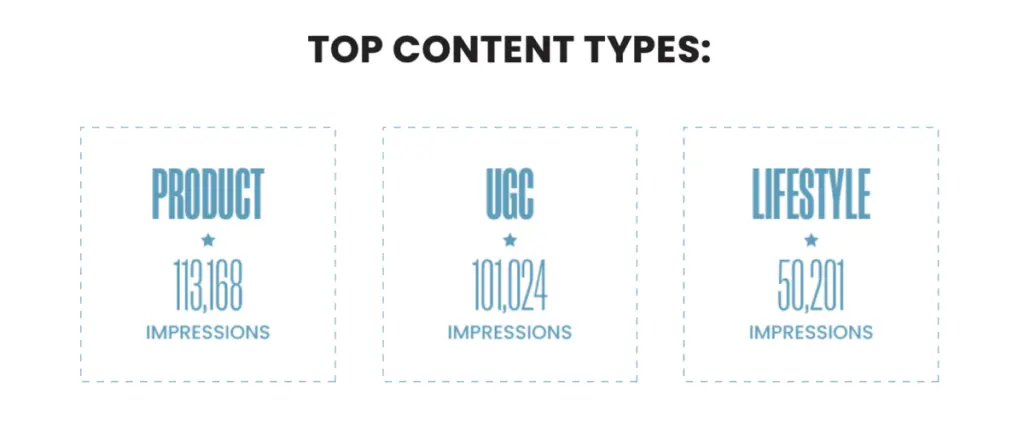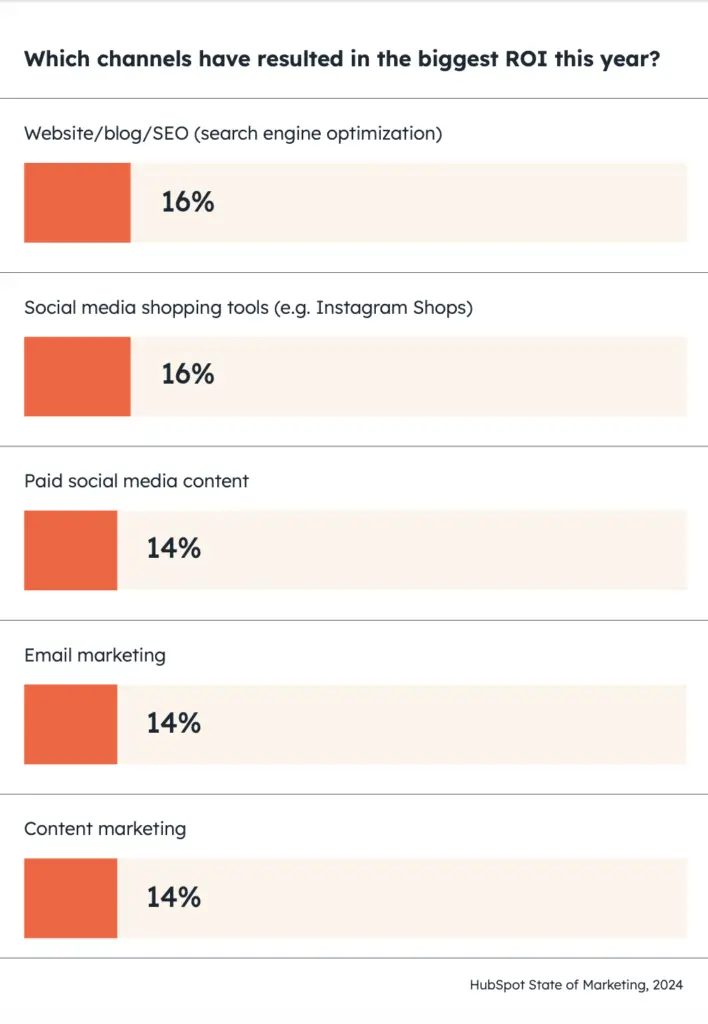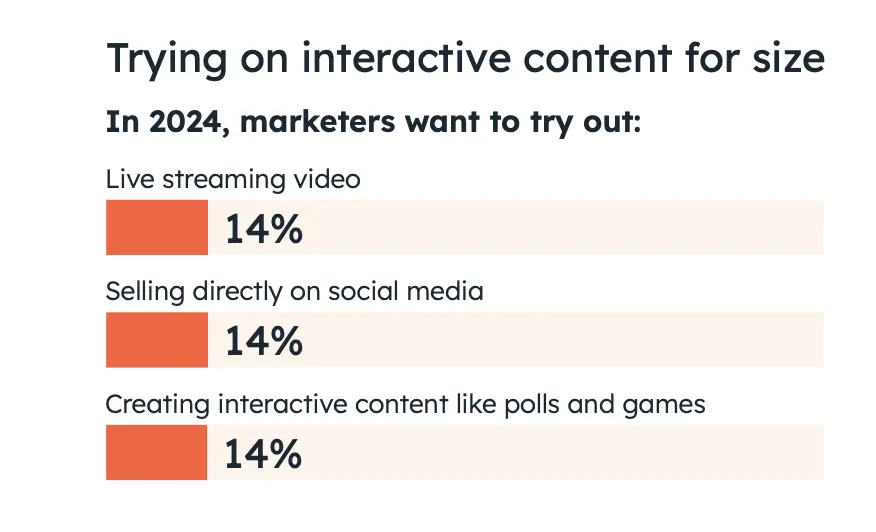Even though there’s a variety of strategies that marketing teams can explore, it’s easy to get stuck and fall back on what you know or have generated results in the past. Our Digital Marketing Benchmark Report 2024 found that the biggest challenge in digital marketing today is the increasing competition.
This makes it even more crucial that brands and marketing teams are continuously exploring new digital marketing ideas. Here’s a look at what type of campaigns data suggests consumers resonate with, along with examples of how brands are implementing it.
Top 7 Digital Marketing Ideas for 2024
1. Influencer Marketing
With our increased emphasis on the many facets of digital marketing, it’s easy to forget the original focus of this site — influencer marketing. However, it’s still as important as it’s ever been.
Here’s what our latest benchmark report about the state of influencer marketing reveal:
- The influencer marketing industry is set to reach about $24 billion by the end of 2024.
- 85% of the 3,000+ marketing agencies and brands interviewed believe that it’s an effective marketing strategy.
- 60% of the respondents plan to increase their influencer marketing budget in 2024. In fact, nearly a quarter plan to allocate over 40% of their entire marketing budget on influencer campaigns.
For some ideas of how you can implement an influencer marketing campaign, you can check out the work Ubiquitous completed for Litter-Robot, a self-cleaning litter box. It’s an example of how influencer marketing leaves enough room to combine creativity with proprietary tech.
The campaign ran for eight weeks, but planning already started three months before the Little Robot 4’s release date. The agency identified the following three channels:
- TikTok
- YouTube
One of the reasons for using multiple channels is that it allowed them to reach potential customers across various stages of the buyer’s journey. Instagram and TikTok were used to generate interest, while content on YouTube focused on driving conversion.
Once they knew which channels to focus on, the agency set out to identify cat accounts that posted regularly and had a loyal following. Using their proprietary tech’s filtering options, they could narrow it down to influencers with older audiences with more disposable income to buy a $700 litter box.
TikTok and Instagram influencers were given more creative freedom. They could focus less on the technical aspects and instead capture the unboxing moment.
As YouTube was used for conversion, they followed a slightly different approach. They cast their net to include tech reviewers. For example, Snazzy Labs with over a million YouTube subscribers fitted the bill as he was also a cat owner.
The results:
- 88 TikTok posts
- 39 Instagram posts
- Nearly 70 million views on TikTok and Instagram with an average cost per mile (CPM) of $4.50
- 360,000 YouTube video views
- 93,000 site visits
- Six figures in revenue for the launch of Little Robot 4
2. Social Media Marketing
As we saw in our Social Media Marketing Benchmark Report 2024, the average internet user spends nearly 2.5 hours on social media each day. Combine this with the fact that nearly 75% of internet users turn to social platforms for brand info and it becomes one of the most promising digital marketing mediums.
According to The Sprout Social Index Edition XIX Report, consumers specifically want information about new products or services. Nearly 70% listed this as their main reason for following a brand on social.
When creating content about your new product on social, keep it non-promotional, though. The same Sprout Social report reveals that consumers want to see more authentic content followed by:
- Business practices and values
- Product manufacturing details
- Educational content about the brand’s niche
- Customer testimonials
- User-generated content (UGC)
For an example of how you can use social media strategically, there’s the work Firebelly Marketing completed for R-C Ranch. Over the span of two years, they focused on:
- Video (specifically Instagram Reels)
- UGC content
- Giveaways
One of their suggestions was that R-C Ranch told a visual story that showed the brand’s family aspects to increase emotional involvement among their target audience. It’s this type of authentic content that looks at brand values and the story behind its products that Sprout Social’s data suggests consumers crave.
The videos featuring the founder, Ryan Cade, generated tens of thousands of impressions. As for content types, content that featured the actual product received slightly more impressions, followed by UGC (once again proving Sprout Social’s data).
3. User-generated Content (UGC)
Touched upon briefly in the previous point, UGC can be one of the most rewarding digital marketing ideas to explore. Aside from alleviating your own content creation efforts, it adds that level of social proof that’s often needed for shoppers to convert.
In fact, Semrush’s 2024 The Vision of a New Social Era: Social Media Trends Report predicts that in the coming year(s) UGC will generate deeper engagement than high-production content. As Lucas O’Keefe, social media strategist and host of the Creator Juice podcast, explains, it’s because this type of content is more trustworthy and authentic.
While it goes hand in hand with social media marketing, it can also be repurposed and turned into website content. For example, Sephora has a whole gallery on their website dedicated to UGC. Here, website visitors can browse pics and videos shared by their Beauty Insider Community members.
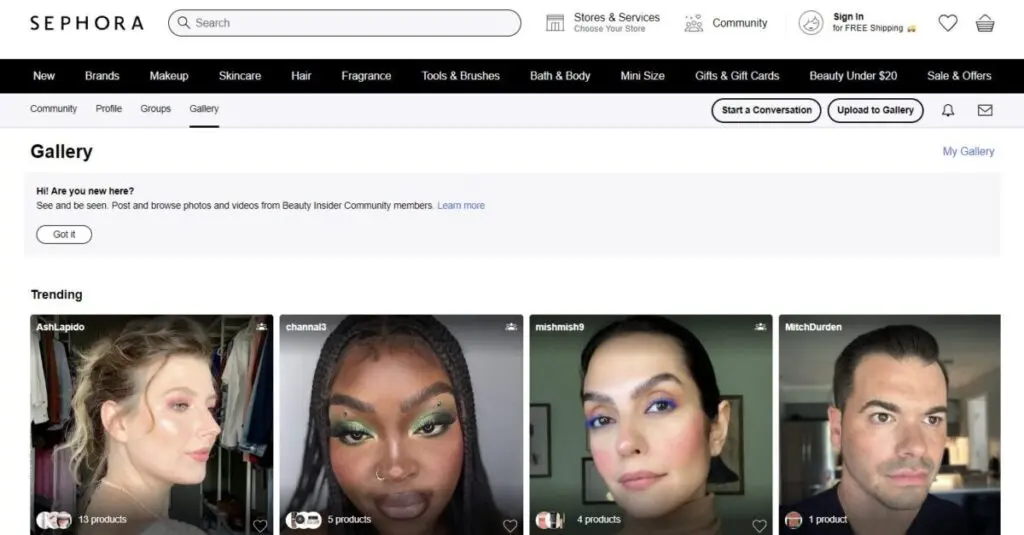
Source: sephora.com
Sephora also makes it easy for users to share their own UGC. You can either upload your own photos or videos via its website or simply mention the brand on social media to get featured potentially on their website.
Another easy way to encourage customers to share content featuring your product is to use a hashtag. Instead of having to mention your brand directly, like in the case of Sephora, you can ask them to add a branded hashtag. This is what GoPro has done, helping them generate millions of potential assets.
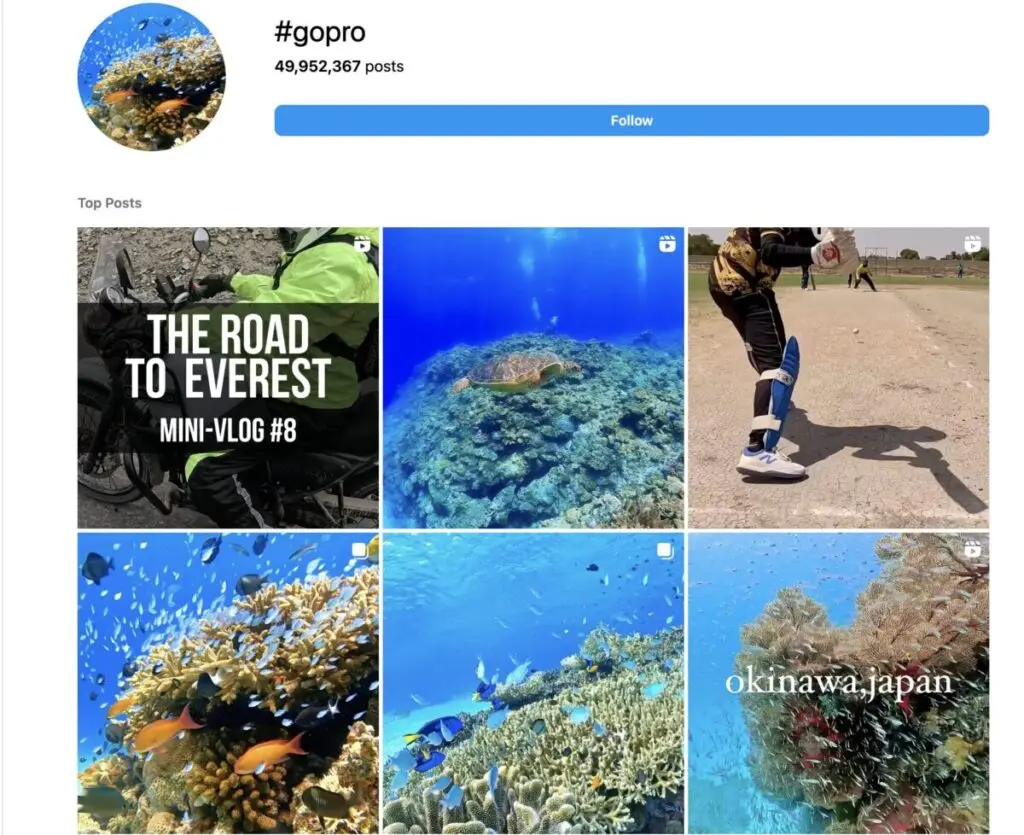
Source: instagram.com
While photos and videos work well because of their visual nature, you can also include other types of UGC like:
- Online reviews
- Ratings
- Customer testimonials
- Social media comments
- Blog comments
For example, reviews can be displayed on your home page, while product ratings can be included on the specific product page.
Patagonia, for example, uses Yotpo, to gather and display reviews on their websites. To date, they have nearly 200,000 product reviews.
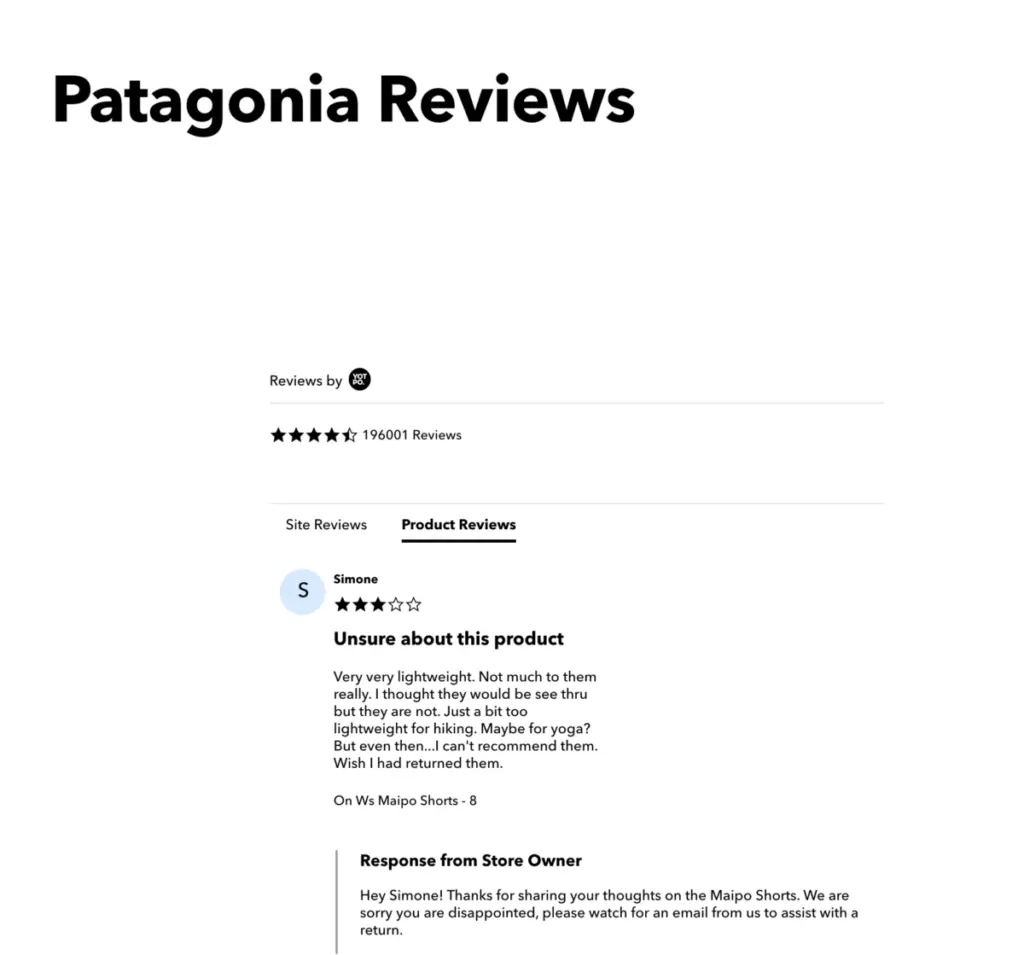
Source: patagonia.com
Reviews, though, don't necessarily have to be just text as Patagonia’s example also shows. Customers can also upload photos. With the robust filtering options, browsers can then filter reviews to display reviews with photos, for instance.

Source: patagonia.com
4. Employee-generated Content (EGC)
UGC can also come from your own employees. Like your customers, employees sharing their insights can offer that level of authenticity and transparency essential for digital marketing nowadays.
The “Visionaries” in Semrush’s Social Media Trends Report agree that when brands are in the hiring process, they should also assess individuals on their social media communication skills. Individuals who are literate in social media communication and skilled in storytelling can act as brand ambassadors, helping to bring brands closer to their customers.
Incorporating EGC into your strategy can be especially useful for businesses operating in the SaaS industry. Let’s face it, screenshots of an interface — no matter how intuitive it is — are rather boring.
However, if it’s a video clip of employees celebrating a recent successful integration like Olga Vasylieva, senior marketing manager at Oaky, has shared on her LinkedIn page, you’ll draw more attention.
EGC can also be a great way to give your target audience insight into your company culture. As mentioned earlier, insight into business practices and brand values are also content that consumers want to see more of.
A company retreat, for example, can present a great opportunity for EGC. Employees will need little to no encouragement to share their pics of swimming pools and sundowners.
However, if there’s no budget for a leisure trip, organizing a team outing or handing out company swag can also encourage posting. Aside from creating brand awareness and familiarity among your target audience, these types of posts can also streamline recruitment efforts.
All in all, Buffer serves as one of the best examples of brands using EGC. And, no, EGC isn’t limited to the recent company retreat. Employees also post about other benefits like the ability to expense any book they want or work remotely.
To leverage this form of UGC successfully, it’s recommended that you can create an employee activation program. This will offer encouragement to employees to be their authentic selves, while at the same time offering them guidelines so that it benefits both your brand and the employees.
5. Social Commerce
Although social commerce has been slow to take off in the West, it’s now becoming more common. Statista reports that between 2021 and 2023, the number of social shoppers in the US increased from about 97 million to close to 107 million. What’s more, forecasts suggest that in 2028 the gross merchandise value of social commerce will be double the estimated value for 2024.
Platforms like Instagram, Facebook, TikTok, Pinterest all recognize users’ growing expectation to be able to make purchases from inside their social apps rather than having to go to a different eCommerce store.
For example, on Instagram, you can leverage shoppable posts and shoppable stories.
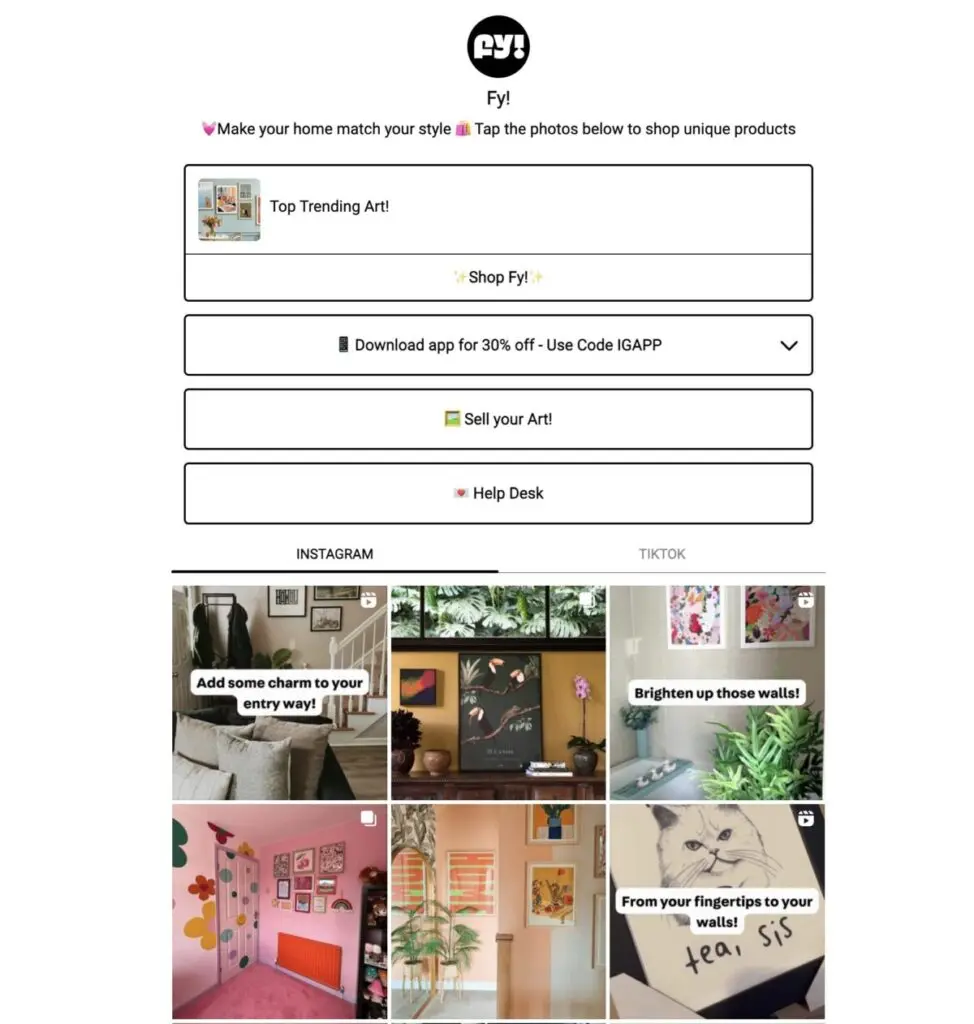
Source: linkin.bio
Then, there’s Facebook Shops where you can import a product catalog and connect with potential customers through Messenger, WhatsApp, or Instagram Direct.
For an example of how to leverage social selling, you can refer to what e.l.f. Cosmetics have done. They were the first brand to be featured in a TikTok Shop Super Brand Day that was held from 31 March - 3 April 2024.
To mark this special day, they revealed their newest holy grail product — the Power Grip Dewy Setting Spray. Instead of boring potential customers with an ordinary product demo, they wrote an original song to explain how to use the product.
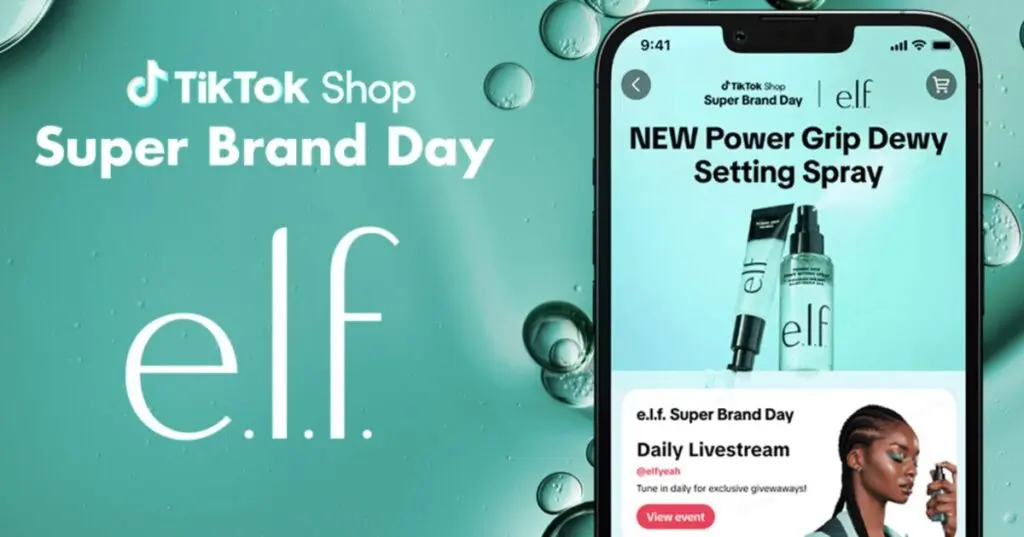
Source: investor.elfbeauty.com
According to Nicolas Le Bourgeois, Head of TikTok Shop US Operations, this is why the brand’s digital marketing ideas work:
“e.l.f. has thrived on TikTok Shop by creatively engaging with our community and building exciting, culturally relevant moments.”
It’s about finding a way to excite and entertain shoppers. And, often that’s by music, across all cultures.
6. Creative Content Marketing
People have an insatiable demand for content. According to HubSpot’s The State of Marketing 2024 report, 14% of marketers feel that content marketing has resulted in the biggest return on investment (ROI).
Slightly more marketers (16%) feel that their website, blog, and/or search engine optimization (SEO) drove the biggest ROI. However, the reality is that firms need content for these channels too.
Content is what you share on social media, include on your website, link to in your emails, and share with your paid social. You can truly consider content as being the backbone of all your digital marketing.
As for what type of content delivers impressive ROI, the same HubSpot report reveals that content showing brand values generates strong results. Marketers also plan on trying out interactive content like:
- Live streaming video
- Polls
- Games
Ben Steele, managing editor at Search Engine Journal, explains that to succeed at content marketing, you need to focus on what users need. He adds that to reflect Google’s recent updates, your content must be personal and demonstrate experience.
As HubSpot explains in its report:
“There’s no substitute for direct, first-hand experience”.
As such, they recommend that you use individual personalities and creators to your advantage. You can, for example, build thought leaders within your organization and, at the same time, experiment with new media formats like videos and podcasts.
These digital marketing suggestions tie in with some of the ideas we’ve discussed earlier:
- Litter-Robot’s influencer marketing campaign uses individual creators. Snazzy Labs shared his first-hand experience using the product and how it made all the difference when his cat battled with health problems, illustrating how content can make first-hand experiences even more personal.
- R-C Ranch’s social media marketing example discussed uses video to introduce the rancher, an individual personality within the business.
Here are more content marketing ideas that you can try:
- High-quality blog posts addressing buyer’s challenges
- Newsworthy press releases sharing brand developments, new products, or software updates
- Personalized social posts encouraging ongoing conversation
- Visually appealing infographics sharing the latest data about your industry
- GIFs illustrating how to use your product
- Value-packed eBooks offering help with your target audience’s pain points
- Email newsletters sharing updates and exclusive offers
- White papers exploring what customers should consider before they buy your type of product
- Case studies that include customer quotes and explore the greater benefits offered by your service
- Reports offered as a lead magnet that share industry trends and insights to give readers a competitive advantage
For example, the benchmark reports that Influencer Marketing Hub creates generate quality backlinks regularly. It has helped us land exposure on leading publications like Forbes and websites of top-rated tools like Meltwater, for example.

Source: forbes.com

Source: meltwater.com

Source: crunchbase.com
In fact, according to Crunchbase, our consistent release of benchmark reports and guides shows that we’re growing and maintaining our relevance and authority in the industry.
7. Customer Segmentation
Customer segmentation isn’t so much a distinct, digital marketing strategy such as content or influencer marketing, but rather a key to successful digital marketing. It’s especially useful for email marketing and pay-per-click (PPC) campaigns.
Basically, it refers to the practice of dividing customers into groups using shared characteristics.
It helps ensure that you reach the right customers with your message at the right time, giving it a big advantage over other traditional forms of marketing.
Examples of characteristics that are typically used to segment your customers include:
- Age
- Gender
- Relationship/marital status
- Location
- Language
- Industry
- Profession
- Purchase history
- Lifestyle
- Hobbies
- Values
Aside from helping you deliver more timely messages, it also enables you to personalize your content.
For example, Island Olive Oil Company combines customer segmentation with email marketing with the help of Omnisend’s segmentation and automation features. They focus on two things: creating a welcome and abandoned cart series.
New subscribers receive a three-part email series that introduces the brand and its popular products.
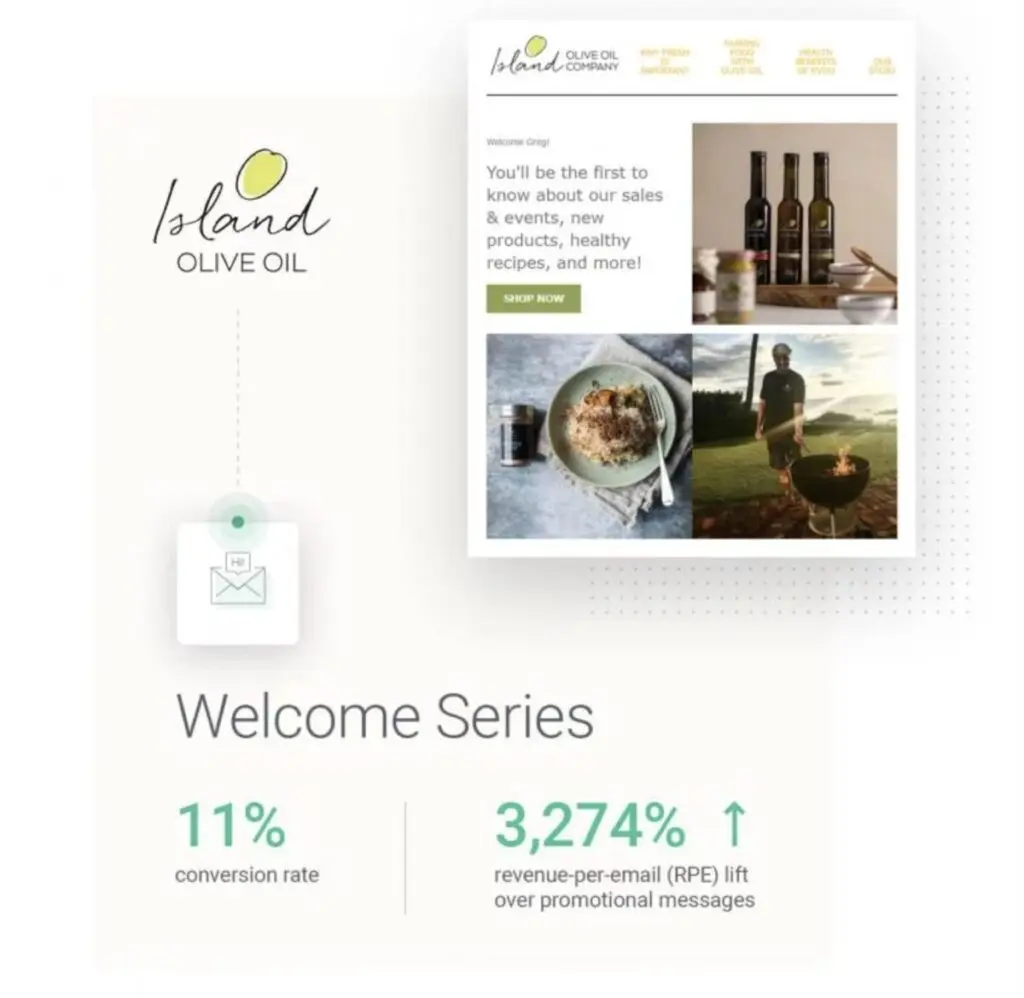
Source: omnisend.com
Then, to recapture those customers who’ve abandoned a cart, they created a specific email for those who showed interest in two of their best-selling products. These potential customers receive emails with a recipe and product suggestions.
Another way that they use segmentation is by looking at the cart value. Depending on the amount, some customers will receive a message about free shipping.
As mentioned, you can also use customer segmentation for PPC campaigns. The most common PPC platforms have particularly sophisticated customer segmentation built in.
For example, you can use Facebook's custom audiences feature to segment your customer base or even create a lookalike audience of similar types of people as your current customers.
The Thailand-based Sensodyne team used both lookalike audiences and custom audiences to boost brand awareness. In fact, they found that the video ad campaign shown to lookalike audiences generated an ad recall that was as much as 6 times higher than the campaign targeted to broad audiences.
Key Takeaways
Digital marketing is a dynamic field that demands authenticity and personalization. Authentic messages, rooted in real experiences, resonate more deeply with audiences and foster stronger connections.
Looking ahead, we can expect these trends to intensify:
- Influencer marketing will continue to evolve, with micro-influencers playing a significant role in niche markets.
- User-generated content will also gain traction, as brands seek genuine, customer-driven narratives.
- Social media marketing will remain at the forefront, with platforms constantly innovating to capture user attention.
- And let's not forget the power of video — whether it's live streaming, short-form videos, or interactive content, video will undoubtedly be crucial in engaging audiences.
Frequently Asked Questions
Which digital marketing channel has the highest ROI?
Social media. This is based on Influencer Marketing Hub’s Digital Marketing Benchmark Report 2024 that surveyed hundreds of marketers and analyzed industry reports, case studies, and expert opinions. Compared to other channels, it requires little upfront investment, helping to deliver a higher return on investment.
What are some of the best digital marketing ideas to try?
Here are some of the most popular digital marketing ideas:
- Email marketing, specifically email newsletters or personalized emails like a cart abandonment reminder sent to specific customer segments
- Social media marketing that leverages short-form videos and repurposes user-generated content
- Influencer marketing campaigns launched on multiple channels
- PPC ads
- Employee-generated content like LinkedIn posts and videos
What are some ideas to fill your content calendar?
Here are some ideas you can add to your social media content calendar:
- Sharing breaking news
- Posting a quote
- Sharing a funny meme
- Conducting a poll
- Placing an employee in the spotlight
- Quoting a satisfied customer
- Sharing a short product demo video
- Answering a frequently asked question
What can I create a blog post about?
Examples of popular blog post ideas that you can write about include:
- 30-day challenges
- Book or product reviews
- Trending rumors
- Top statistics
- Industry-relevant news
- Success stories
- Future predictions
- Product updates
- New team members

